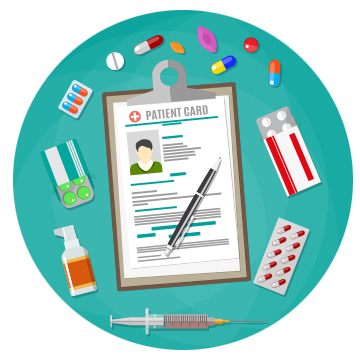Module 1: Professional Accountability and Prescribing
Lesson 6
Exercise: Truth or myth?
Think about the following statements, and then click the check box beside each to reveal if they are true or a myth. Consider why you think the statement is true or a myth.
Myth
Stigma is often based on negative value judgements on all things psychological. To refute stigma, providers and patients may utilize the phrase “real pain” to deny the presence of psychological pain. Pain has both physical and psychological components requiring multiple treatment modalities to manage.
Reference:
- Institute for Chronic Pain. (2015). How to end the stigma of pain.
Myth
This myth is related to confusion about physiological dependence and addiction. For example, persons who are given opioids for pain may experience withdrawal symptoms resulting from physiological dependence when no longer taking the medication. The presence of withdrawal symptoms is not necessarily associated with underlying addiction.
Reference:
- Addiction science and research centre, University of Texas. (2016). Drug Myths.
Myth
Psychoactive prescription drugs contain chemicals that tap into the brain’s communication system and disrupt the way nerve cells normally send, receive, and process information. This disruption is caused by imitating the brain’s natural chemical messengers and by overstimulation of the “reward circuit” of the brain. Long-term use causes long-term brain changes that support compulsive, addictive use of the drug.
Reference:
- National Institute of Drug Abuse. (2012). Drug facts: Understanding drug abuse and addiction.
Myth
Although there is a correlation between substance use problems and mental illness, this cannot be generalized to the entire population. Approximately 20% of people with a mental illness have a co-occurring substance use problem, and similarly, people with substance use problems are up to three times more likely to have a mental illness. However, those with mental health problems, through treatment, often have better coping strategies preventing inappropriate drug use than individuals without a mental health disorder.
Reference:
- Centre for Addiction and Mental Health (2015). Mental illness and addictions: Facts and statistics.
Myth
First Do No Harm: Responding to Canada’s Prescription Drug Crisis — Annual Report, 2013–2014 shows increased reports of problem use rates across the country. These include rising rates for use of prescription drugs without a prescription, increased admission rates for opioid treatment programs and increased opioid-related deaths in all population groups. Canada is the second largest per capita consumer of prescription opioids (exceeded only by the United States).
Reference:
Truth
The experience of pain results from the severity of any condition underlying the pain (medical), the sensitivity of the nervous system (psychological), and how well the person with pain is coping (psychological).
Reference:
- Institute for Chronic Pain. (2015). How to end the stigma of pain.
Myth
This is controversial, however, most medical resources consider chronic chemical dependence to psychoactive prescriptive drugs as a medical brain disease driven by genetic vulnerability. Others claim that addiction is a developmental disorder where a habit becomes an addiction and treatment includes dismantling the habit.
Reference:
- Swanson, J. (2014, October 14). Habit or Addiction: Who Decides. The Fix.
- Falk, D. (2015, August 14). Biological desire: Why addiction is not a disease. The Globe and Mail.
Truth
Addiction treatment programs often centre on assisting the client to find a sense of hope and purpose in their lives. Health care providers require skills to assist clients in their personal quest for purpose.
Reference:
- Centre for Addiction and Mental health (2016). Quest for purpose.
Myth
Infants older than one month of age metabolize drugs in the same manner as older infants and children. Careful selection of appropriate dose and dosing schedule, as well as frequent monitoring for desired and undesired effects, can minimize any potential adverse effects.
Reference:
- Registered Nurses Association of Ontario (2013). Clinical Best Practice Guidelines: Assessment and management of pain.
Truth
Beliefs are shaped through past experiences, age, education, culture or ethnicity, and gender. For example, some beliefs related to pain that may influence patient requests for pain control in cancer care (Al-Atiyyat, 2008, cited in RNO, 2013) are
- fear of addiction;
- concern about drug tolerance;
- belief that adverse effects from analgesics are even more bothersome than pain;
- fatalism (i.e., a resigned attitude) about the possibility of achieving pain control;
- belief that ‘‘good’’ patients do not complain about pain;
- fear of distracting a health care provider from treating the disease;
- belief that pain signifies disease progression; and
- fear of injections.
Clinicians are known to undertreat pain using controlled subtances because of a lack of education and experience working with substance misuse, fear of exacerbating or creating an addiction, fear of respiratory depression, and difficulty assessing whether the patient really needs the medication (da Cunha, 2015).
Reference:
- Registered Nurses Association of Ontario (2013). Clinical Best Practice Guidelines: Assessment and management of pain.
- da Cunha, B. (2015). Ethics and undertreatment of pain in patients with a history of drug abuse. Academy of Medical-Surgical Nurses, 24(1)
Myth
Health professionals such as physicians, nurses, and pharmacists, who are knowledgeable about drugs have an incidence of addiction that is at least as high as the general population.
Reference:
- Addiction science and research centre, University of Texas. (2016). Drug Myths.
- National Advisory Council on Prescription Drug Misuse. (2013). First do no harm: Responding to Canada’s prescription drug crisis.
Myth
This belief underlies the concept of pseudoaddiction, however, differentiating pseudoaddiction from true addiction is difficult since the underlying behaviours in both (drug-seeking) are indistinguishable. Empirical evidence to support this concept is limited.
Reference:
- Green, M., & Chambers, R. (2015). Pseudoaddiction: Fact or fiction? An investigation of the medical literature. Current Addiction Report;, 2(4), 310–317. doi:10.1007/s40429-015-0074-7.
